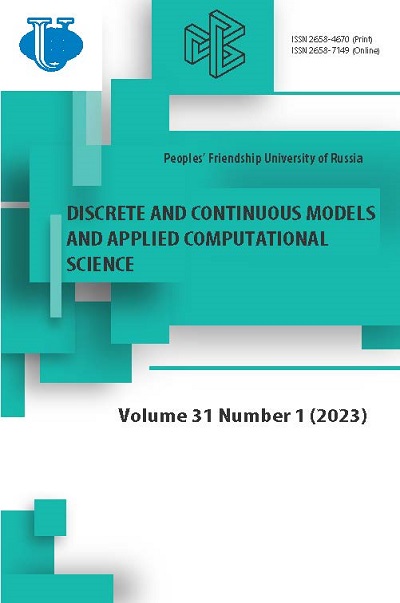Vol 31, No 1 (2023)
- Year: 2023
- Articles: 5
- URL: https://journals.rudn.ru/miph/issue/view/1651
- DOI: https://doi.org/10.22363/2658-4670-2023-31-1
Full Issue
Julia language features for processing statistical data
Abstract
The Julia programming language is a specialized language for scientific computing. It is relatively new, so most of the libraries for it are in the active development stage. In this article, the authors consider the possibilities of the language in the field of mathematical statistics. Special emphasis is placed on the technical component, in particular, the process of installing and configuring the software environment is described in detail. Since users of the Julia language are often not professional programmers, technical issues in setting up the software environment can cause difficulties that prevent them from quickly mastering the basic features of the language. The article also describes some features of Julia that distinguish it from other popular languages used for scientific computing. The third part of the article provides an overview of the two main libraries for mathematical statistics. The emphasis is again on the technical side in order to give the reader an idea of the general possibilities of the language in the field of mathematical statistics.
 5-26
5-26


Construction, stochastization and computer study of dynamic population models “two competitors - two migration areas”
Abstract
When studying deterministic and stochastic population models, the actual problems are the formalization of processes, taking into account new effects caused by the interaction of species, and the development of computer research methods. Computer research methods make it possible to analyze the trajectories of multidimensional population systems. We consider the “two competitors - two migration areas” model, which takes into account intraspecific and interspecific competition in two populations, as well as bidirectional migration of both populations. For this model, we take into account the variability of the reproduction rates of species. A formalized description of the four-dimensional model “two competitors - two migration areas” and its modifications is proposed. Using the implementation of the evolutionary algorithm, a set of parameters is obtained that ensure the coexistence of populations under conditions of competition between two species in the main area, taking into account the migration of these species. Taking into account the obtained set of parameters, a positive stationary state is found. Two-dimensional and three-dimensional projections of phase portraits are constructed. Stochastization of the model “two competitors - two migration areas” is carried out based on the method of self-consistent one-step models constructing. The Fokker-Planck equations are used to describe the structure of the model. A transition to a four-dimensional stochastic differential equation in the Langevin form is performed. To carry out numerical experiments, a specialized software package is used to construct and study stochastic models, and a computer program based on differential evolution is developed. Algorithms for generating trajectories of the Wiener process and multipoint distributions and modifications of the Runge-Kutta method are used. In the deterministic and stochastic cases, the dynamics of the trajectories of populationmigration systems is studied. A comparative analysis of deterministic and stochastic models is carried out. The results can be used in modeling of different classes of dynamic systems.
 27-45
27-45


Causality relationship between foreign direct investments and economic improvement for developing economies: Russia case study
Abstract
Foreign direct investment (FDI) can have a significant impact on economic development in developing economies like Russia. FDI can bring in capital, technology, and management expertise that can stimulate economic growth, increase employment, and improve productivity. In the case of Russia, FDI has played a vital role in the country’s economic development. A study conducted by the World Bank in 2019 found that FDI inflows have contributed significantly to Russia’s economic growth and led to increased productivity, employment, and exports. The article analyzes the relationship between foreign direct investment and economic growth in Russia using ARDL cointegration and Toda-Yamamoto causality analysis test. The results reveal that there is no causality relation between GDP growth and foreign direct investment inflow in Russia. Overall, foreign direct investment effectively contributes to economic growth in Russia in the short term and not really in the long run.
 46-63
46-63


Methods of extracting biomedical information from patents and scientific publications (on the example of chemical compounds)
Abstract
This article proposes an algorithm for solving the problem of extracting information from biomedical patents and scientific publications. The introduced algorithm is based on machine learning methods. Experiments were carried out on patents from the USPTO database. Experiments have shown that the best extraction quality was achieved by a model based on BioBERT.
 64-74
64-74


Studying the mechanism of electric explosion of metal conductors
Abstract
The article gives a description of the history of the development of research of electric explosion of metal conductors, the authors offer a modern view on the physics of the process of electric explosion. The result of such an explosion can be, in particular, the production of nanopowders, which today have found the widest application in industry, agriculture, medicine, and so on.
 75-86
75-86
















